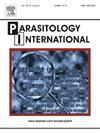Invisible burden: Prevalence of Chagas disease in Latin American migrants in Turin, North-Western Italy – A STROBE compliant-cross-sectional study
IF 1.5
4区 医学
Q3 PARASITOLOGY
引用次数: 0
Abstract
Objectives
Chagas disease (CD), or American trypanosomiasis, is a parasitic disease caused by Trypanosoma cruzi, primarily transmitted by triatomine bugs. Increased travels and migrations introduced CD to non-endemic regions, including Europe. In Italy, the disease has raised public attention mainly in northern regions, where Latin American migrant population is larger.
This study aims to describe a CD screening initiative in Turin, Piedmont, during the World Chagas disease Day. We focused on migrants from CD endemic countries of Latin America.
Methods
A total of 63 serum samples from Latin American migrants were collected and tested for CD with a chemiluminescence immunoassay (CLIA) for initial screening, followed by Western Blot (WB) for confirmation, analyzing demographic data.
Results
Out of the 63 individuals screened, two tested positive for CD. Both positive cases were from Bolivia. Seropositive individuals were 54 and 72 years-old, and lived in Bolivia for 31 and 69 years.
Conclusions
The screening initiative suggests an underestimated prevalence of CD among Latin American migrants in Turin, underscoring the need of targeted public health interventions and emphasizing the importance of CD screening and awareness programs.
无形的负担:意大利西北部都灵拉美移民恰加斯病患病率--一项符合 STROBE 标准的横断面研究。
目的:恰加斯病(CD)又称美洲锥虫病,是一种由克鲁兹锥虫引起的寄生虫病,主要通过三蠹蝽传播。旅行和移民的增加将南美锥虫病带到了非流行地区,包括欧洲。在意大利,这种疾病主要在拉美移民人口较多的北部地区引起了公众的关注。本研究旨在描述皮埃蒙特都灵在世界南美锥虫病日期间开展的南美锥虫病筛查活动。我们重点关注来自拉丁美洲南美锥虫病流行国家的移民:方法:我们共收集了 63 份来自拉丁美洲移民的血清样本,并使用化学发光免疫分析法(CLIA)对其进行了初步筛查,随后使用 Western Blot(WB)进行了确认,并对人口统计学数据进行了分析:结果:在接受筛查的 63 人中,有两人的 CD 检测结果呈阳性。两个阳性病例均来自玻利维亚。血清阳性者的年龄分别为 54 岁和 72 岁,在玻利维亚分别居住了 31 年和 69 年:筛查结果表明,都灵的拉丁美洲移民中 CD 的发病率被低估了,这凸显了有针对性的公共卫生干预措施的必要性,并强调了 CD 筛查和宣传计划的重要性。
本文章由计算机程序翻译,如有差异,请以英文原文为准。
求助全文
约1分钟内获得全文
求助全文
来源期刊

Parasitology International
医学-寄生虫学
CiteScore
4.00
自引率
10.50%
发文量
140
审稿时长
61 days
期刊介绍:
Parasitology International provides a medium for rapid, carefully reviewed publications in the field of human and animal parasitology. Original papers, rapid communications, and original case reports from all geographical areas and covering all parasitological disciplines, including structure, immunology, cell biology, biochemistry, molecular biology, and systematics, may be submitted. Reviews on recent developments are invited regularly, but suggestions in this respect are welcome. Letters to the Editor commenting on any aspect of the Journal are also welcome.
 求助内容:
求助内容: 应助结果提醒方式:
应助结果提醒方式:


